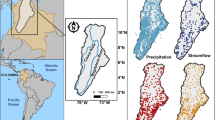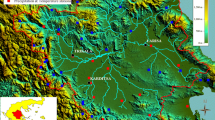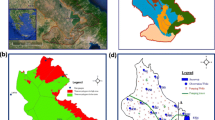Abstract
Central Asia features an extreme continental climate with mostly arid to semi-arid conditions. Due to low precipitation and therefore low water availability, water is a scarce resource and often the limiting factor for socio-economic development. The aim of this model study was to compare the uncertainties of hydrological modelling induced by global and regional climate data sets and to calculate the impacts on estimates of renewable water resources. Within this integrated model study the hydrological and water use model Water Global Assessment and Prognosis 3 (WaterGAP 3) is being applied to all river basins located in Kazakhstan, Kyrgyzstan, Tajikistan, Turkmenistan, Uzbekistan, and Mongolia in five arc minutes spatial resolution (~6 × 9 km/grid cell). The model was driven by different global and regional climate data sets to estimate their impact on modelled water resources in Central Asia. In detail, these are the global TS data set of the Climate Research Unit (CRU), the WATCH forcing data (WFD) developed within the EU–FP6 Project “WATer and global Change”, the Global Precipitation Climatology Centre (GPCC) Reanalysis product v6, and the regional Aphrodite’s Water Resources data set (Aphrodite). The performance of the model is then being evaluated by comparing modelled and observed river discharge for the time period 1971–2000. Finally, the uncertainties in modelled water availability induced by the different data sets are quantified to point out the consequences for water management. Over the entire region, mean and maximum annual precipitations given by the various data sets differ by 13 % and up to 42 %, respectively. In addition, considerable deviation of temporal dynamics is found in some locations, where a pairwise comparison showed poor agreement between CRU and GPCC/WFD (Nash–Sutcliffe efficiency 0.27/0.23). Thus, also modelled discharge shows high temporal and spatial variations which leads to differences in median model efficiency of 0.11 between the data sets.








Similar content being viewed by others
References
Alcamo J, Henrichs T (2002) Critical regions: a model-based estimation of world water resources sensitive to global changes. Aquat Sci 64:352–362. doi:10.1007/PL00012591
Alcamo JM, Döll P, Henrichs T, Kaspar F, Lehner B, Rösch T, Siebert S (2003) Development and testing of the WaterGAP2 global model of water use and availability. Hydrol Sci J 48:317–337. doi:10.1623/hysj.48.3.317.45290
Alcamo J, Flörke M, Märker M (2007) Future long-term changes in global water resources driven by socio-economic and climatic changes. Hydrol Sci J 52(2):247–275. doi:10.1623/hysj.52.2.247
Aus der Beek T, Flörke M, Lapola DM, Schaldach R, Voß F, Teichert E (2010) Modelling historical and current irrigation water demand on the continental scale: Europe. Adv Geosci 27:79–85. doi:10.5194/adgeo-27-79-2010
Aus der Beek T, Voß F, Flörke M (2011) Modelling the impact of global change on the hydrological system of the Aral Sea basin. Phys Chem Earth 36(13):684–694. doi:10.1016/j.pce.2011.03.004
Bosilovich MG, Chen J, Robertson FR, Adler RF (2008) Evaluation of global precipitation in reanalyses. J Appl Meteorol Clim 47:2279–2299. doi:10.1175/2008JAMC1921.1
Cowan PJ (2007) Geographic usage of the terms Middle Asia and Central Asia. J Arid Environ 69:359–363. doi:10.1016/j.jaridenv.2006.09.013
Curtis GE (1997) Kazakhstan, Kyrgyzstan, Tajikistan, Turkmenistan, and Uzbekistan: country studies (area handbook series). Claitor’s Publishing Division, p 570
Döll P, Kaspar F, Lehner B (2003) A global hydrological model for deriving water availability indicators: model tuning and validation. J Hydrol 270:105–134. doi:10.1016/S0022-1694(02)00283-4
Dukhovny VA, Sokolov V (2009) Integrated water resources management: putting a good theory into practice: experience of Central Asia. Water Int 34(2):287–290. doi:10.1080/02508060902937504
Farr TG, Kobrick M (2000) Shuttle radar topography mission produces a wealth of data. Eos Trans AGU 81:583–585. doi:10.1029/EO081i048p00583
Fekete BM, Vörösmarty CJ, Roads JO, Willmott CJ (2003) Uncertainties in precipitation and their impacts on runoff estimates. J Clim 17:294–304. doi:10.1175/1520-0442(2004)017<0294:UIPATI>2.0.CO;2
Flörke M, Kynast E, Bärlund I, Eisner S, Wimmer F, Alcamo J (2013) Domestic and industrial water uses of the past 60 years as a mirror of socio-economic development: a global simulation study. Global Environ Chang 23:144–156. doi:10.1016/j.gloenvcha.2012.10.018
Haddeland I, Clark DB, Franssen W, Ludwig F, Voß F, Arnell NW, Bertrand N, Best M, Folwell S, Gerten D, Gomes S, Gosling SN, Hagemann S, Hanasaki N, Harding R, Heinke J, Kabat P, Koirala S, Oki T, Polcher J, Stacke T, Viterbo P, Weedon GP, Yeh P (2011) Multimodel estimate of the global terrestrial water balance: setup and first results. J Hydrometeorol 12:869–884. doi:10.1175/2011JHM1324.1
Hagg W, Braun LN, Kuhn M, Nesgaard TI (2007) Modelling of hydrological response to climate change in glacierized Central Asian catchments. J Hydrol 332:40–53. doi:10.1016/j.jhydrol.2006.06.021
Hagg W, Mayer C, Lambrecht A, Kriegel D, Azizov E (2013) Glacier changes in the Big Naryn basin, Central Tian Shan. Global Planet Change 110(Part A):40–50. doi:10.1016/j.gloplacha.2012.07.010
Harris I, Jones PD, Osborn TJ, Lister DH (2013) Updated high-resolution grids of monthly climatic observation—the CRU TS3.10 Dataset. Int J Climatol. doi:10.1002/joc.3711
IPCC (2012) Managing the risks of extreme events and disasters to advance climate change adaptation. In: Field CB, Barros V, Stocker TF, Qin D, Dokken, DJ, Ebi KL, Mastrandrea MD, Mach KJ, Plattner G-K, Allen SK, Tignor M, Midgley PM (eds) A Special Report of Working Groups I and II of the Intergovernmental Panel on climate change. Cambridge University Press, Cambridge, NY, p 582
Jakeman AJ, Giupponi C, Karssenberg D, Hare M, Fassio A, Lettcher RA (2006) Integrated management of water resources: concepts, approaches and challenges. In: Giupponi C, Jakeman AJ, Karssenberg D, Hare MP (eds) Sustainable management of water resources: an integrated approach. Elgar Publishing, Cheltenham, pp 3–24. doi:10.4337/9780857937117.00007
Kaser G, Großhauser M, Marzeion B (2010) Contribution potential of glaciers to water availability in different climate regimes. Proc Natl Acad Sci 107(47):20223–20227. doi:10.1073/pnas.1008162107
Kauffeldt A, Halldin S, Rodhe A, Xu C-Y, Westerberg IK (2013) Disinformative data in large-scale hydrological modeling. Hydrol Earth Syst Sci 17:2845–2857. doi:10.5194/hess-17-2845-2013
Konovalov VG (2007) Long-term changes of water balance components in the Basins of Rivers fed by snow and ice. Russ Meteorol Hydrol 32(8):529–537. doi:10.3103/S1068373907080092
Kottek M, Grieser J, Beck C, Rudolf B, Rubel F (2006) World Map of the Köppen-Geiger climate classification Updated. Meteorol Z 15(3):259–263. doi:10.1127/0941-2948/2006/0130
Krause P, Doyle DP, Bäse F (2005) Comparison of different efficiency criteria for hydrological model assessment. Adv Geosci 5:89–97. doi:10.5194/adgeo-5-89-2005
Kriegel D, Mayer C, Hagg W, Vorogushyn S, Duethmann D, Gafurov A, Farinotti D (2013) Changes in glacierisation, climate and runoff in the second half of the 20th century in the Naryn basin, Central Asia. Global Planet Change 110(Part A):51–61. doi:10.1016/j.gloplacha.2013.05.014
Kundzewicz ZW, Merz B, Vorogushyn S, Hartmann H, Duethmann D, Wortmann M, Huang S, Su B, Jiang T, Krysanova V (2014) Observed changes in climate and river discharge in the Aksu River Basin. Environ Earth Sci
Lioubimtseva E, Henebry GM (2009) Climate and environmental change in arid Central Asia: impacts, vulnerability, and adaptations. J Arid Environ 73:963–977. doi:10.1016/j.jaridenv.2009.04.022
Lioubimtseva E, Cole R, Adams JM, Kapustin G (2005) Impacts of climate and land-cover changes in arid lands of Central Asia. J Arid Environ 62(2):285–308. doi:10.1016/j.jaridenv.2004.11.005
Ludwig R, May I, Turcotte R, Vescovi L, Braun M, Cyr J-F, Fortin L-G, Chaumont D, Biner S, Chartier I, Caya D, Mauser W (2009) The role of hydrological model complexity and uncertainty in climate change impact assessment. Adv Geosci 21:63–71. doi:10.5194/adgeo-21-63-2009
Malsy M, Aus der Beek T, Eisner S, Flörke M (2012) Climate change impacts on Central Asian water resources. Adv Geosci 32:77–83. doi:10.5194/adgeo-32-77-2012
Malsy M, Heinen M, aus der Beek T, Flörke M (2013) Water resources and socio-economic development in a water scarce region on the example of Mongolia. Geo-Öko 34:27–49
Millennium Ecosystem Assessment (MEA) (2005) Ecosystems and human well-being: synthesis. Island Press, Washington DC 137
MoMo-Consortium (2009): MoMo—IWRM in Central Asia—Model Region Mongolia (MoMo): case study in the Kharaa River Basin. In: Final project report, p 201
Nash JE, Sutcliffe JV (1970) River flow forecasting through conceptual models part I—a discussion of principles. J Hydrol 10(3):282–290. doi:10.1016/0022-1694(70)90255-6
Pahl-Wostl C, Tàbara D, Bouwen R, Craps M, Dewulf A, Mostert E, Ridder D, Taillieu T (2008) The importance of social learning and culture for sustainable water management. Ecol Econ 64:484–495. doi:10.1016/j.ecolecon.2007.08.007
Piani C, Weedon GP, Best M, Gomes SM, Viterbo P, Hagemann S, Haerter JO (2010) Statistical bias correction of global simulated daily precipitation and temperature for the application of hydrological models. J Hydrol 395:199–215. doi:10.1016/j.jhydrol.2010.10.024
Priestley CHB, Taylor RJ (1972) On the assessment of surface heat flux and evaporation using large-scale parameters. Mon Weather Rev 100(2):81–92. doi:10.1175/1520-0493(1972)100<0081:OTAOSH>2.3.CO;2
Rakhmatullaev S, Huneau F, Kazbekov J, Le Coustumer P, Jumanov J, El Olfi B, Motelica-Heino M, Hrkal Z (2010) Groundwater resources use and management in the Amu Darya River Basin (Central Asia). Environ Earth Sci 59(6):1183–1193. doi:10.1007/s12665-009-0107-4
Rakhmatullaev S, Huneau F, Celle-Jeanton H, Le Coustumer P, Motelica-Heino M, Bakiev M (2013) Water reservoirs, irrigation and sedimentation in Central Asia: a first-cut assessment for Uzbekistan. Environ Earth Sci 68(4):985–998. doi:10.1007/s12665-012-1802-0
Rudolf B, Becker A, Schneider U, Meyer-Christoffer A, Ziese M (2011) New GPCC Full Data Reanalysis Version 5 provides high-quality gridded monthly precipitation data. Gewex, p 2
Sattarov MA, Eshmirzoyev IE, Rakhimov F (2006) Problems of estimation and rational use of water resources of Aral Sea basin. In: Proceedings of International Scientific Conference extreme hydrological events in Aral and Caspian sea region. Moscow, pp 269–274, 19–20 October 2006
Savenije HHG, Hoekstra AY, van der Zaag P (2013) Evolving water science in the Anthropocene. Hydrol Earth Syst Sci Discuss 10:7619–7649. doi:10.5194/hessd-10-7619-2013
Savoskul OS, Smakhtin V (2013) Glacier systems and seasonal snow cover in six major Asian river basins: hydrological role under changing climate. In: Colombo, Sri Lanka: International Water Management Institute (IWMI). IWMI Research Report 150, p 53
Scharaw B, Westerhoff T (2011) A leak detection in drinking water distribution network of Darkhan in framework of the project IWRM in Central Asia, Model Region Mongolia. In: Гypинoвич AД (ed) Proceedings of the IWA 1st Central Asian Regional Young and Senior Water Professionals Conference, Almaty, pp 275–282
Schewe J, Heinke J, Gerten D, Haddeland I, Arnell NW, Clark DB, Dankers R, Eisner S, Fekete B, Colon-Gonzalez FJ, Gosling SN, Kim H, Liu X, Masaki Y, Portmann FT, Satoh Y, Stacke T, Tang Q, Wada Y, Wisser D, Albrecht T, Frieler K, Piontek F, Warszawski L, Kabat P (2013) Multi-model assessment of water scarcity under climate change. Proc Natl Acad Sci USA. doi:10.1073/pnas.1222460110
Schneider U, Becker A, Finger P, Meyer-Christoffer A, Rudolf B, Ziese M (2011) GPCC Full Data Reanalysis Version 6.0 at 0.5°: monthly land-surface precipitation from rain-gauges built on gts-based and historic data
Siebert S, Burke J, Faures JM, Frenken K, Hoogeven J, Döll P, Portmann FT (2010) Groundwater use for irrigation—a global inventory. Hydrol Earth Syst Sci 14:1863–1880. doi:10.5194/hess-14-1863-2010
Sivapalan M, Savenije HHG, Blöschl G (2012) Socio-hydrology: a new science of people and water. Hydrol Process 26(8):1270–1276. doi:10.1002/hyp.8426
The World Bank (2013) World DataBank: World development indicators. http://data.worldbank.org/data-catalog/world-development-indicators
UNEP (2005) Aral Sea. In: Severskiy I, Chervanyov I, Ponomarenko Y, Novikova NM, Miagkov SV, Rautalahti E, Daler D (eds) GIWA Regional assessment 24, University of Kalmar, Kalmar, pp 92
Unger-Shayesteh K, Vorogushyn S, Farinotti D, Gafurov A, Duethmann D, Mandychev A, Merz B (2013) What do we know about past changes in the water cycle of Central Asian headwaters? A review. Global Planet Change 110(Part A):4–25. doi:10.1016/j.gloplacha.2013.02.004
Verzano K (2009) Climate change impacts on flood related hydrological processes: further development and application of a global scale hydrological model, reports on earth system science, 71-2009. Max Planck Institute for Meteorology, Hamburg, pp 166. Available at: http://www.mpimet.mpg.de/fileadmin/publikationen/Reports/WEBBzE71verzano.pdf
Weedon GP, Gomes S, Viterbo P, Österle H, Adam JC, Bellouin N, Boucher O, Best M (2010) The WATCH forcing data 1958–2001: a meteorological forcing dataset for land surface—and hydrological—models. In: WATCH technical report no. 22, pp 41
Weedon GP, Gomes S, Viterbo P, Shuttleworth WJ, Blyth E, Österle H, Adam JC, Bellouin N, Boucher O, Best M (2011) Creation of the WATCH Forcing data and its use to assess global and regional reference crop evaporation over land during the twentieth century. J Hydrometeorol 12:823–848. doi:10.1175/2011JHM1369.1
Weedon GP, Gomes S, Balsamo G, Best MJ, Bellouin N, Viterbo P (2012) WATCH forcing data methodology applied to ERA-Interim data. 3
Worden RL, Savada AM (1991) Mongolia: a country study (area handbook series). In: 2nd edn. Claitor’s Law Books and Publishing Division, p 320
Wouters P, Dukhovny VA, Allan A (2004) Implementing integrated water resources management in Central Asia. In: NATO series IV: earth and environment vol 77. Springer, London, Limited
Yatagai AO, Arakawa K, Kamiguchi H, Kawamoto M, Nodzu I, Hamada A (2009) A 44-year daily gridded precipitation dataset for Asia based on a dense network of rain gauges. SOLA 5:137–140. doi:10.2151/sola.2009-035
Yatagai A, Kamiguchi K, Arakawa O, Hamada A, Yasutomi N, Kitoh A (2012) APHRODITE: constructing a long-term daily gridded precipitation dataset for Asia based on a dense network of rain gauges. B Am Meteorol Soc 93:1401–1415. doi:10.1175/BAMS-D-11-00122.1
Yu F, Price KP, Ellis J, Shi P (2003) Response of seasonal vegetation development to climatic variations in eastern Central Asia. Remote Sens Environ 87(1):42–54. doi:10.1016/S0034-4257(03)00144-5
Acknowledgments
The authors would like to thank the GRDC for the gratuitous provision of observed river runoff data. This work has been supported by the German Federal Ministry of Education and Research project MoMo (Integrated Water Resources Management in Central Asia—Model Region Mongolia—No. 0330762A).
Author information
Authors and Affiliations
Corresponding author
Electronic supplementary material
Below is the link to the electronic supplementary material.
Rights and permissions
About this article
Cite this article
Malsy, M., aus der Beek, T. & Flörke, M. Evaluation of large-scale precipitation data sets for water resources modelling in Central Asia. Environ Earth Sci 73, 787–799 (2015). https://doi.org/10.1007/s12665-014-3107-y
Received:
Accepted:
Published:
Issue Date:
DOI: https://doi.org/10.1007/s12665-014-3107-y




